Everyone knows you need to season a cast iron skillet with some type of oil. After this, the fighting begins. Is vegetable oil best? Do you heat it on the stovetop or the oven? And how often? My answer? Make your own blend, do it when you think it needs it, and enjoy a beautifully shiny non-stick pan that will quite literally outlive you.

Homemade Cast Iron Seasoning Oil
Equipment
- storage jar (half pint mason jar recommended)
Instructions
- Measure and combine the oils. Combine the beeswax and grapeseed oil in a microwave safe container and stir. I highly recommend measuring the oils and melting this right in a mason jar that you will use for storage. This recipe will fit right into a four ounce (half pint) mason jar. If you're using a scale, simply measure the oil and beeswax right into the jar, zeroing out your scale in between.
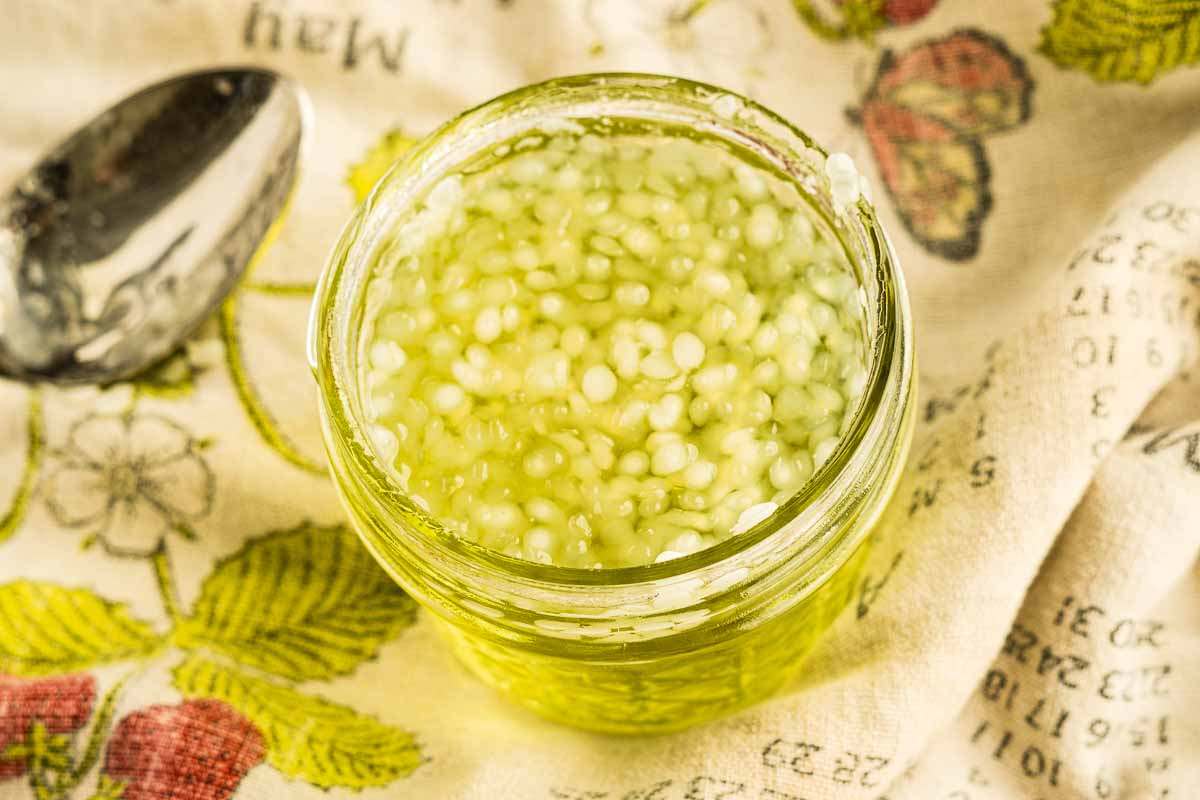
- Heat the oils. Heat in the microwave on LOW in 30 second intervals, stirring in between, until the beeswax in melted. Be careful removing the jar from the microwave: even though the glass won't be hot, the oil inside will be!

- Pour into storage jar. Pour the oil into a storage jar and cover. It will solidify as it cools. It will be soft but solid at room temperature, like shortening. (If you've measured and heated in the mason jar you've already done this!)

- Use to season your cookware. Apply to clean cast iron cookware as needed. Wipe out excess and heat to smoking to season surfaces.

Notes
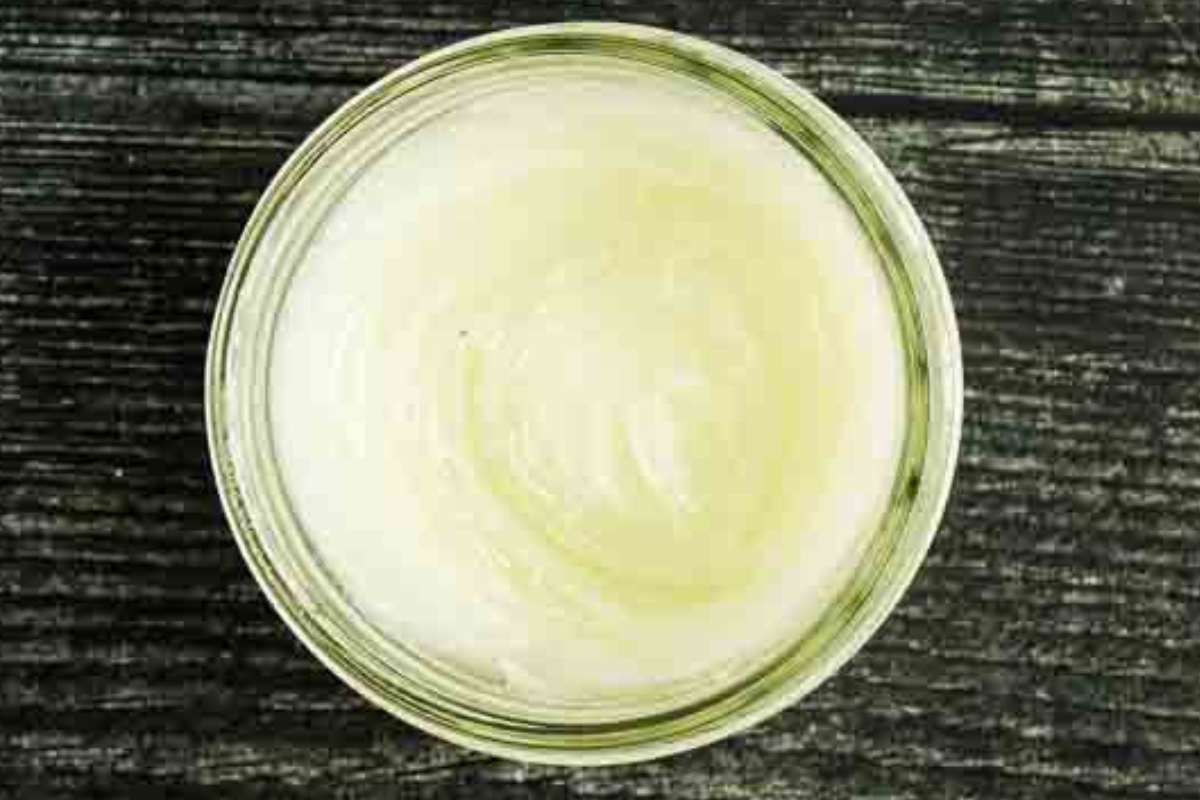
Why You Need to Season New Cast Iron
It’s weird, right?
Well, we love cooking with cast iron because it gets super hot and retains that heat, allowing you to sear your food at high temperatures for a great crust and color. It’s also tough, so you don’t have to worry about chipping it or scratching it.

No logins, No guilt, no Overwhelm
Heirloom Homemaker Email Series

Create a beautiful home life based on routines. We’ll start at the beginning and build you up. Over 2000 women have gone through this and loved it. I promise you will too.
But iron, of course, loves to rust. Any water is its enemy. And it doesn’t have a perfectly smooth surface.
Seasoning takes care of those problems. When a fat is added to the cast iron and heated enough, it forms a bond. A bond that’s non-stick, smooth and protective.
But what oil is best?
A Look at Popular Seasoning Oils
Technically, any oil will work. But the most important consideration is the oil’s smoke point. Let’s take a look at some popular choices and look at the pros and cons
| Oil | Benefits | Drawbacks |
| Extra Virgin Olive Oil | was once mentioned in the New York Times as being the best | expensive, low smoke point, worst choice overall |
| Vegetable Oil | cheap, easy to find, easy to apply | forms a weak bond and can leave a sticky film if you apply too much |
| Shortening | bonds nicely with cast iron pan and the price is right | needs to be applied frequently since it’s not as strong as other methods |
| Coconut Oil | accessible, inexpensive, bonds nicely with cast iron pan | needs to be applied frequently since it’s not as strong as other methods |
| Grapeseed Oil | high smoke point, more affordable than the last two oils | more expensive than vegetable |
| Beeswax | bonds nicely to pan | awkward to get on the pan, not available in most stores, expensive |
| Flaxseed Oil | bonds very well | very expensive |
High Smoke Point + Good Bond
To be clear, you can absolutely use any of the oils above and cook with cast iron successfully! You’ll find that with some you’ll need to season more frequently and some will last longer. It’s just personal preference.
But if you’re willing to take a few minutes to combine two of the best oils, you’ll get a blend that’s truly perfect for cast iron seasoning.
It’s solid at room temperature and looks cute in a small tin by the stovetop. And it only takes a minute to mix up!
Let’s make some, shall we?
What You’ll Need
20 grams beeswax (about 2 tablespoons). If you don’t want to use beeswax, soy wax should work but I haven’t personally tried it.
80 grams grapeseed oil (About 1/3 cup)
A kitchen scale (helpful but not essential)
A glass jar (at least 4 ounces)
Paper towels that aren’t too fuzzy
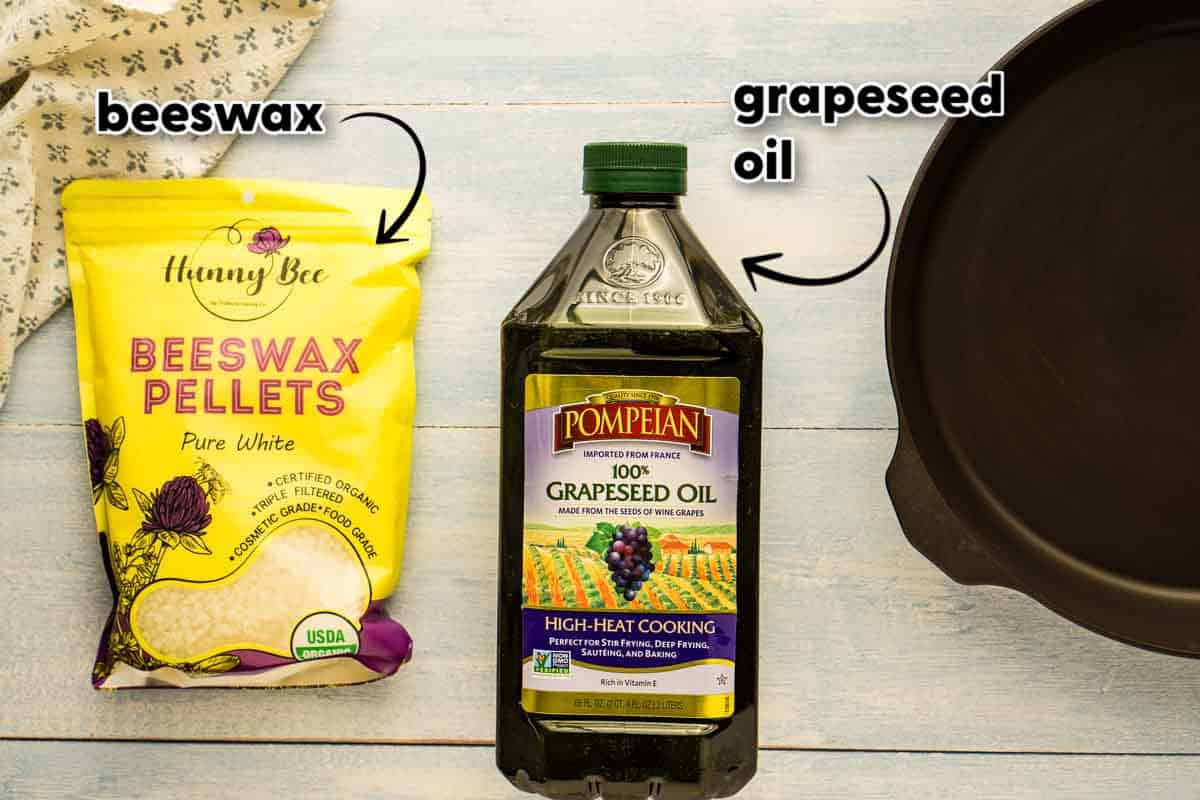
That’s it! We get the advantages of beeswax but only need a little bit, which keeps this oil blend affordable.
The grapeseed oil is comparable in price to a medium-grade olive oil. If you can’t find it in stores, you can easily get it online.
For beeswax, you will have an easier time working with it if you buy the pellets: they melt faster and are easier to measure. (Trying to cut 20 grams off of a bar of beeswax is harder than you’d think.)
The Seasoning Process (Bake or Stovetop)
First, make sure your pan is clean and dry.
A new, unseasoned pan (or an old one you’ve stripped)
Most modern pans come pre-seasoned. If yours doesn’t, rub it with the oil of your choice, using a non-fuzzy paper towel. Wipe out any excess oil until it until it looks almost dry, and place the pan upside down in a 450 degree oven for 1 hour. (Make sure you coat the handles and the back.) Repeat twice.
The layers of seasoning will continue to build up over time, so cook with plenty of fat on low heat for a few weeks. It will get there.
If your pan seems sticky when you’re done, you probably used a bit too much. Scrub it out with steel wool and soapy water (just this once!) and try again, buffing off the extra as much as possible.
Touch up seasoning
Easy! After you’ve cooked, scrub out the pan with a brush and hot water. Towel dry it, then put it on the stovetop and heat it to get it really dry. Lightly rub it with your favorite oil, heat it briefly just until the oil smokes, and let it cool.
Cast Iron Care
- Clean your cast iron with hot water and a scrub brush. Avoid dish soap. It’s not the end of the world if you have to use it, but over time it will break down the seasoning faster.
- Cast iron cookware has to stay dry. Even the most well-seasoned pans will rust if they stay wet. So after every use, towel dry your pans and take an extra minute to heat them on the stove to make sure they are completely dry.
- Cook with cast iron often and don’t be afraid of it. If you cook something acidic in it, like tomatoes, no big deal. Just scrub and season. Don’t let all the rules scare you.
- Use common sense when it comes to seasoning cast iron. If your pan looks dry or is sticking, season it!
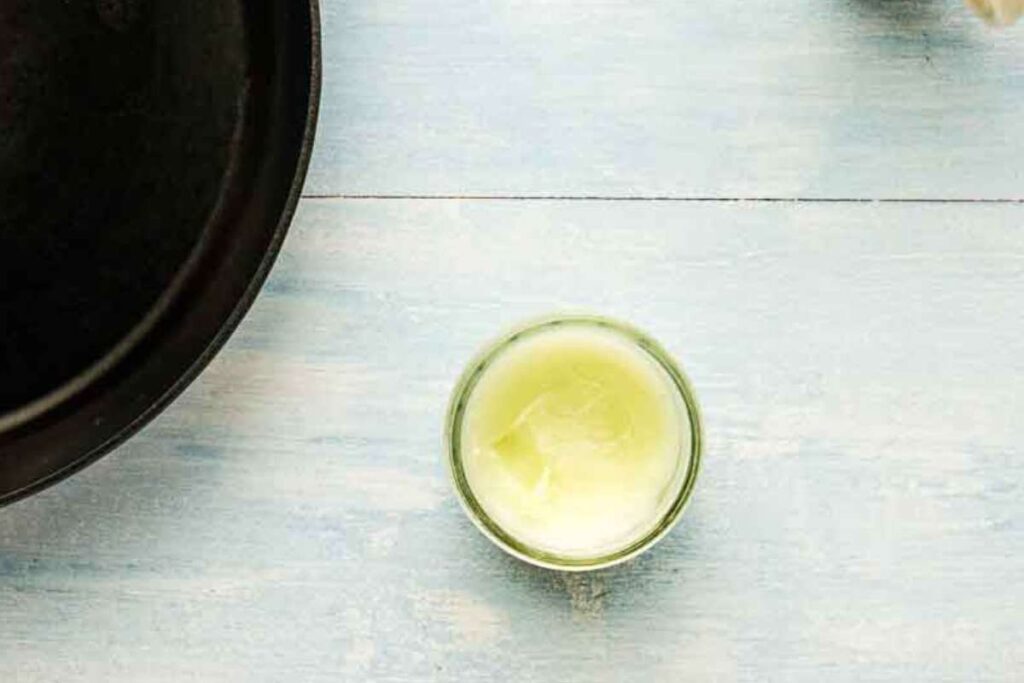


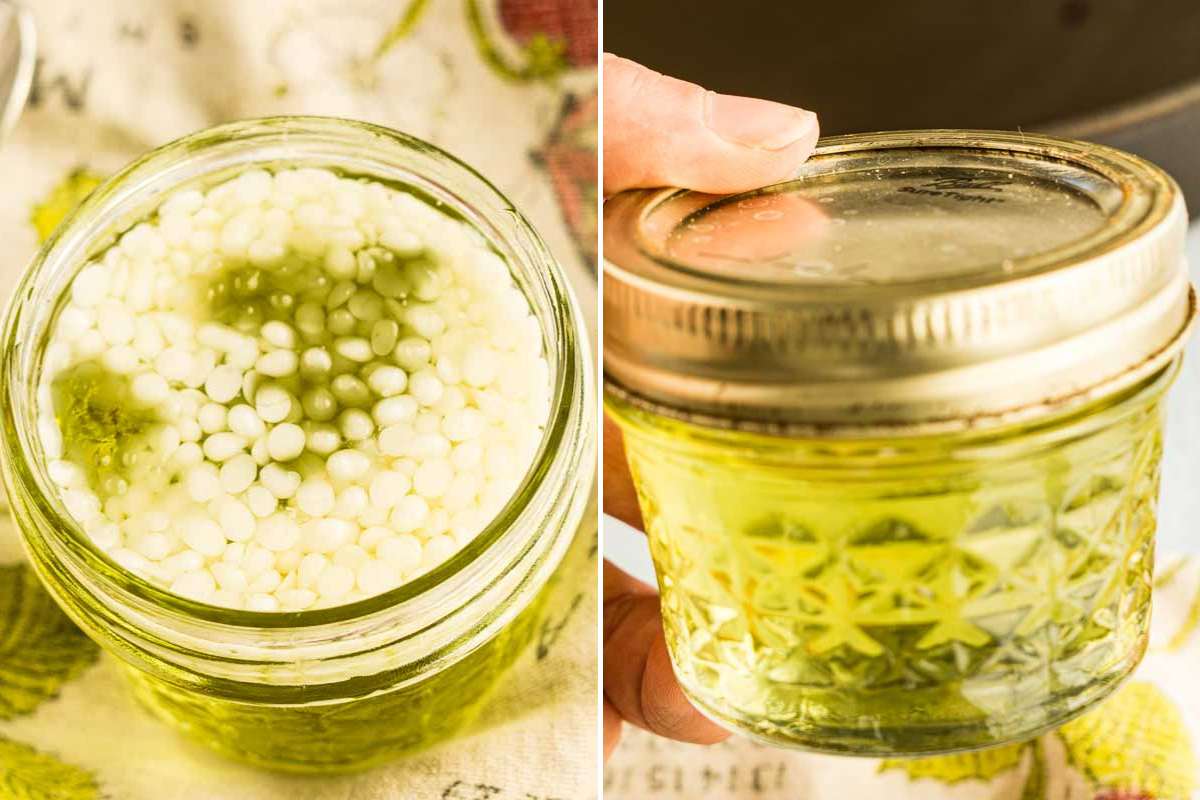
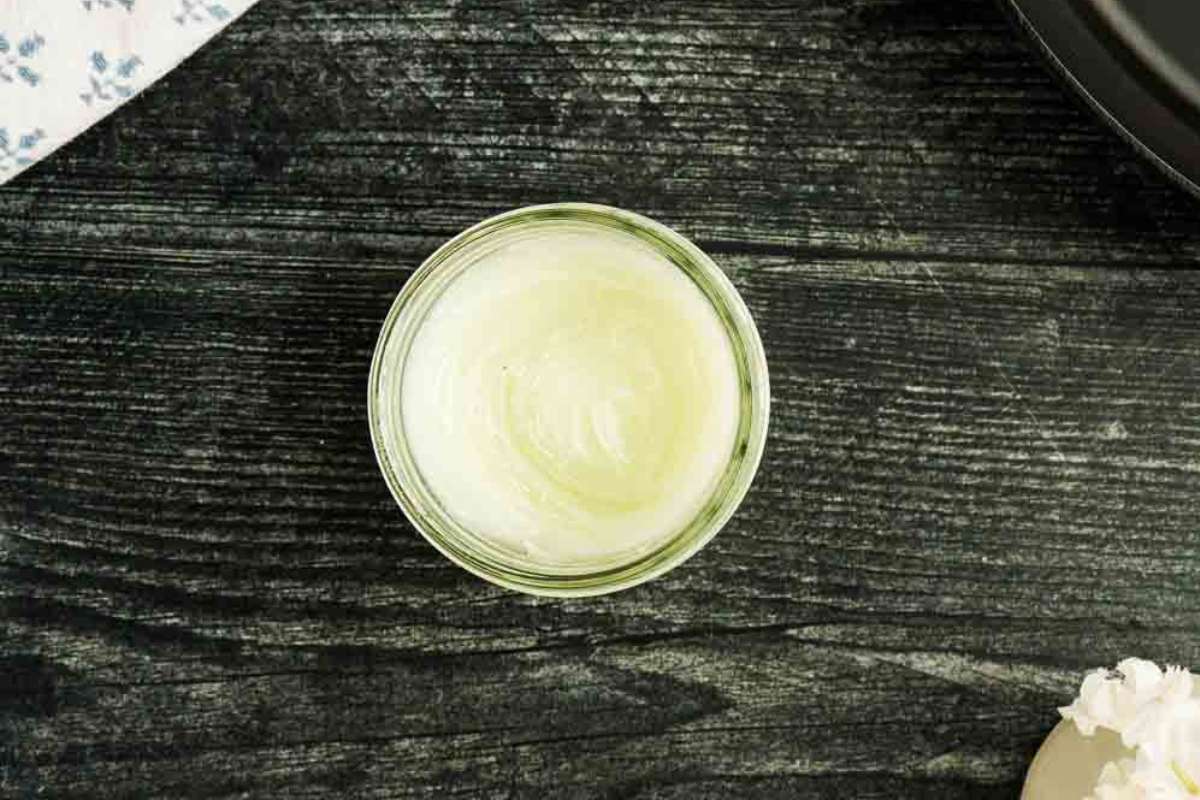
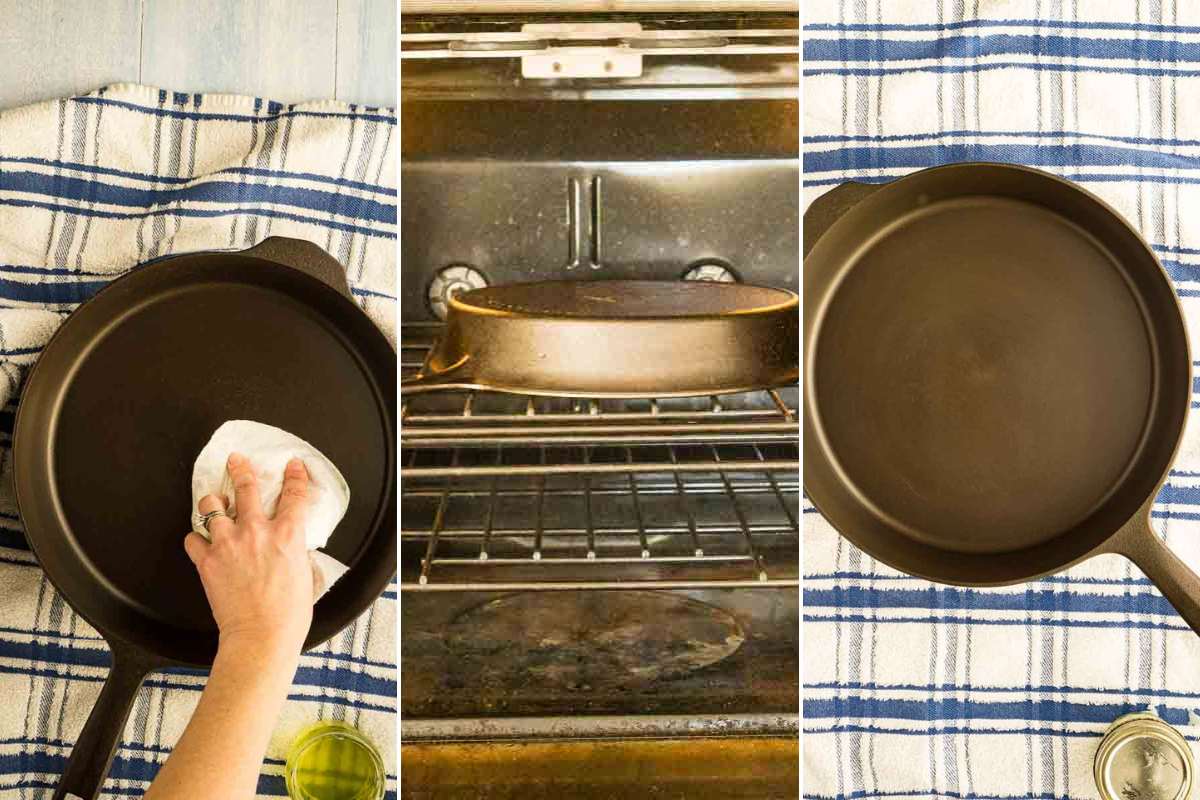
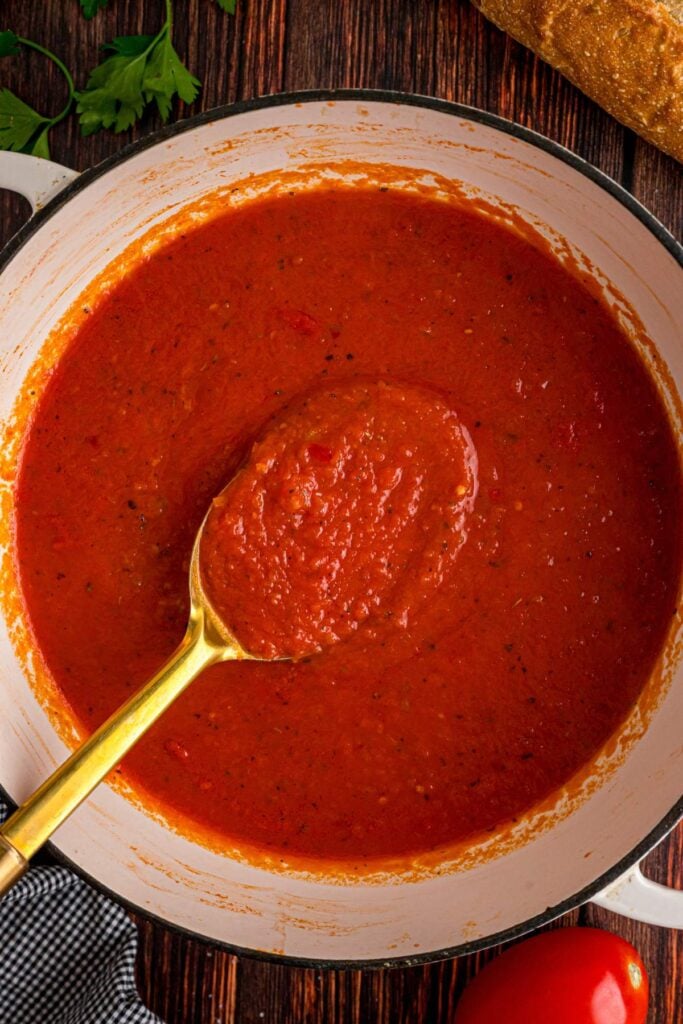
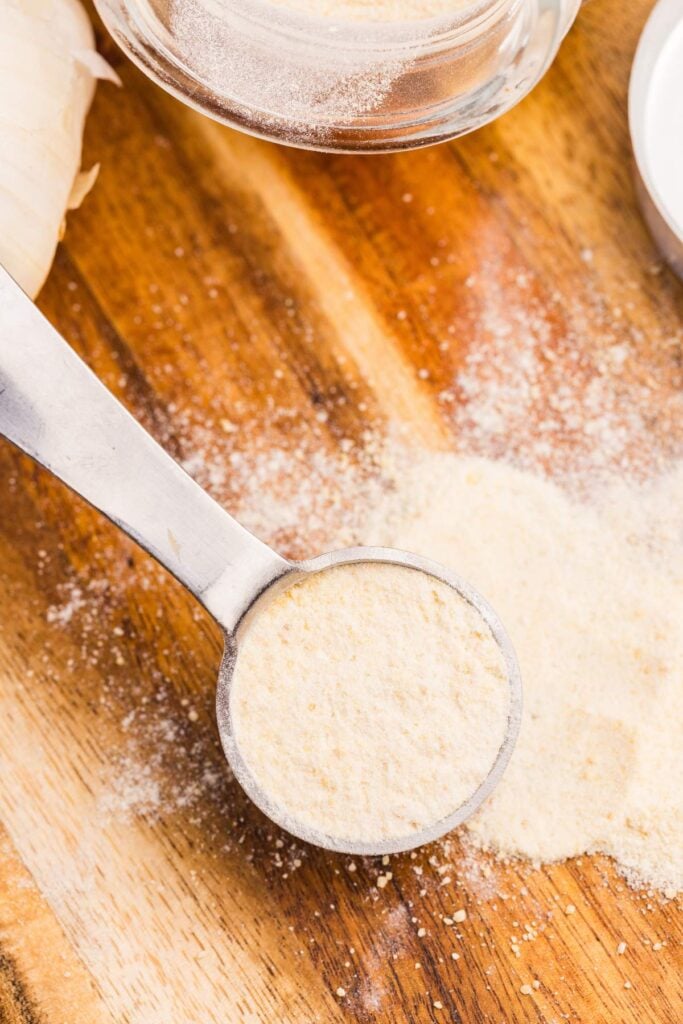
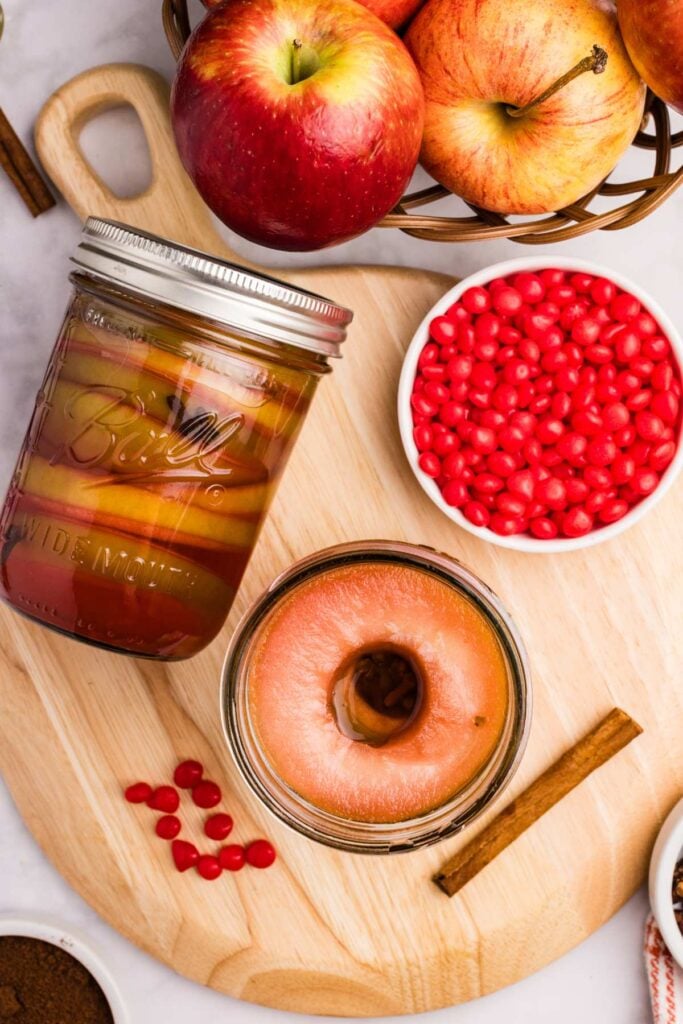
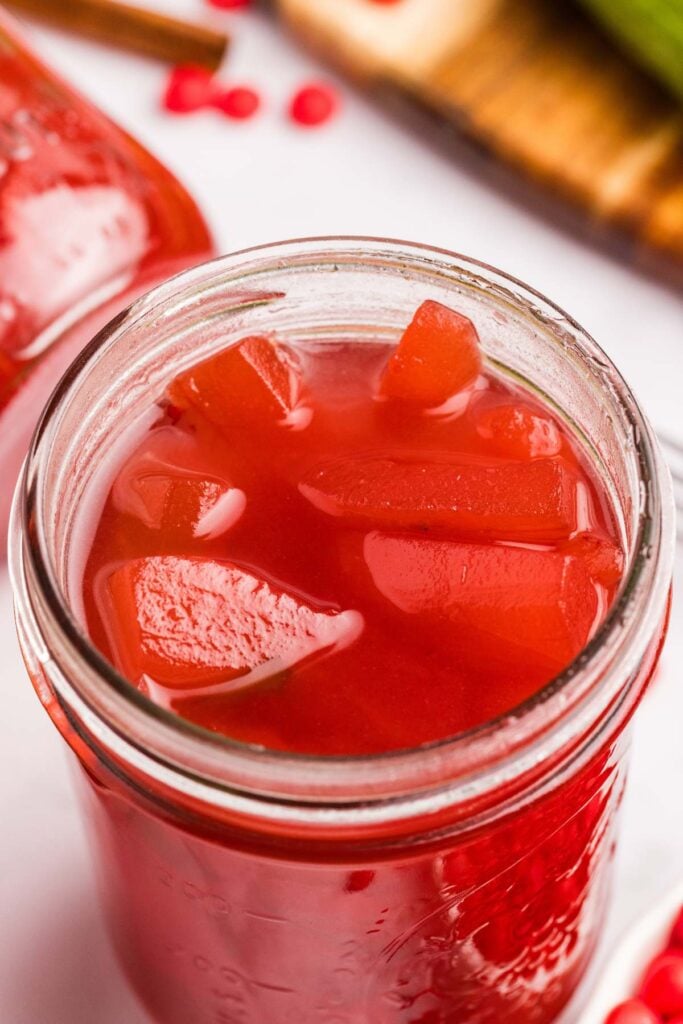
I tried using your link for the beeswax pellets but item is only listed as cosmetic grade. Where are you getting your food grade pellets from nowadays?
hey Matt, azure standard! 🙂
Instead of using a microwave, how about slowly heating in a water bath in a slow cooker? That’s how I un-crystalize my honey.
Do you think this would work well as a spoon butter to protect wooden utensils and cutting boards?
Thanks for the great recipe!
yes that would work, but be careful because beeswax is SUPER flammable. and it’s GREAT on wooden cutting boards 🙂
Hi. I’m VERY interested in making this recipe and will once my beeswax pellets come in from Amazon in 2 days. I know that beeswax doesn’t expire or go bad but I was just wondering if this mix goes bad because of the grapeseed oil and do I need to use it up in a certain amount of time or can I keep it by the stove “forever” to use as I please for years to come?
Hi jeremi, so I know grapeseed. oil has a shorter shelf life. but i’ve had jars of this that have taken me 2 years to get through with no issues. i think since you aren’t eating the. oil (Exccept in tiny amount) it’s no problem
Thanks a lot for the reply Katie! I was just wondering if I needed to hurry up and oil everything I had every single time that I used it to get rid of it or would it be cool to sit on the counter by the stove for a year or 2 until I use it all up. I guess I’ll try to keep smelling it to see if it goes rancid or something. Lol Going to make me a batch of it today though!
Do I just wipe the rag in the jar to apply to pan or am I scooping it? Don’t want to use too much
I use about a dime-sized amount for an 8 inch pan.
no scooping, just lightly dab the seasoning paste. Little goes a long way. after applying( should look shinny, somewhat wet without pooling or excess amount) then wipe it down where the wet look is gone. put in oven for 1hr 15 min at 475-500 degrees. thats it , done!!! it’s easy..good luck
If beeswax is so flammable (above 400) can we not ever use that pan at greater than 400?
No it bonds with the surface of a pan. it would only be problem if you had a puddle of beeswax in there. I use VERY high heat with my skillets 🙂
How often should you use the beeswax recipe on your cast iron pans? Every once in awhile or after each use of your pan?
hey linda, i find that with a new pan i use it every time and then after a while not so often…maybe once a week.
Excellent recipe. It works well on a warmed up bare cast iron cookware. Do not attempt to apply on a cold cast iron. You’ll end up using more than what is necessary. THANK YOU Katie.
This recipe calls for more oil and less beeswax. From the photo of the finished product it seemed soft and like a thick paste. Therefore, this needs a rag to be applied to surfaces. Am I correct? Thank you for sharing this recipe.
yes you’ll need a rag or paper towel 🙂
I already made this today using your recipe but I used 1/2 grape seed and 1/2 sunflower because I have sunflower oil to make it a lot closer to Field’s seasoning oil. All I can say is THIS is an EXCELLENT recipe and my pans looked great after 4 seasoning cycles on my oven. I followed Stephen Muscarella’s tips (preheat to 300°F, wipe off oil some more and increase oven temp to 400°F for final stage about 30 to 60minutes). My pans are way better now. My kitchen is not billowing smoke. Martha Stewart’s tips from 7 yrs ago is meeeh! It made my oven’s glass window matte brown with polymerized oil and I have to spend more elbow grease to clean my oven’s window. I was new to CI back then. Anyway, 2 thumbs up for this recipe. THANK YOU for sharing. Saved me thousands of pesos from ordering a crisbee or Field’s seasoning oil.
awesome! so happy you had success. i love martha stewart’s style but i find her recipes for food and anything else kind of boring and bad, like she never actually made them
Your statement regarding flax seed oil having a high smoke point is incorrect. It has a very low smoke point, 225ºF. Grape seed oil has a smoke point of 420ºF and Avocado oil has one of the highest at 520ºF. Of all the articles I have read by experts on the topic, no one has mentioned beeswax, so that component is suspect.
herb all i can say is that is works very well for me. i hope you find something that works well for you.
Flaxseeed oil has a low smoke point and tends to flake off in my experience. Believe me I have looked into this and also experimented with many hours using different oils in the oven. This is a chart supplied by Lodge on smoke points: Flaxseed is way down on the list of temps. https://www.lodgecastiron.com/cleaning-and-care/cast-iron/oils-cast-iron-cooking-and-seasoning. You are 100% correct though in combing grapeseed oil and beeswax. Avocado oil can also be substituted in for some of the grapeseed oil even though one can not reach the high smoke point in a typical oven.. but to be honest I suspect the grapeseed oil is the star in the equation.
buzzywax works very well, nice slick surface, cleans up well
I hear good things about Buzzy wax and Crusbee waxes for cast iron. They are oils mixed with beeswax and are outrageously expensive. I bought Crisbee and it seems to work great but I will probably go. back to grape seed oil.
This stuff is great for seasoning pans, but It has many more uses. It works as a lip balm. I used it on the bottom of a measuring cup when pressing rice krispy bars into a pan. I’ve also used it to grease and flour the baking pan when baking a cake. I’m sure I will find more uses for it as I go on.
that’s great greg! i need to try some of those too, great idea
It seems the more I use my cast iron the better it gets even without special seasoning. Wish I could go back and learn so many things from my grandmother, one thing being how she cared for her cast iron.
yes I agree! a lot of times cast iron doesn’t need anything special, if you cook the right foods and keep it try.
After initial seasoning, I just cook bacon in it often. Don’t wash it out just wipe it. My cast iron stays very well seasoned.
Another part of the problem with new cast iron is it still has the sand casting grain in the bottom. Over time it will wear smooth, and you’ll find it becomes much more non stick and easier to keep seasoned. I cheat if I have to get a new pan and sand the bottom smooth, but I use an orbital sander, not something I would recommend to do by hand unless you enjoy tedious work.